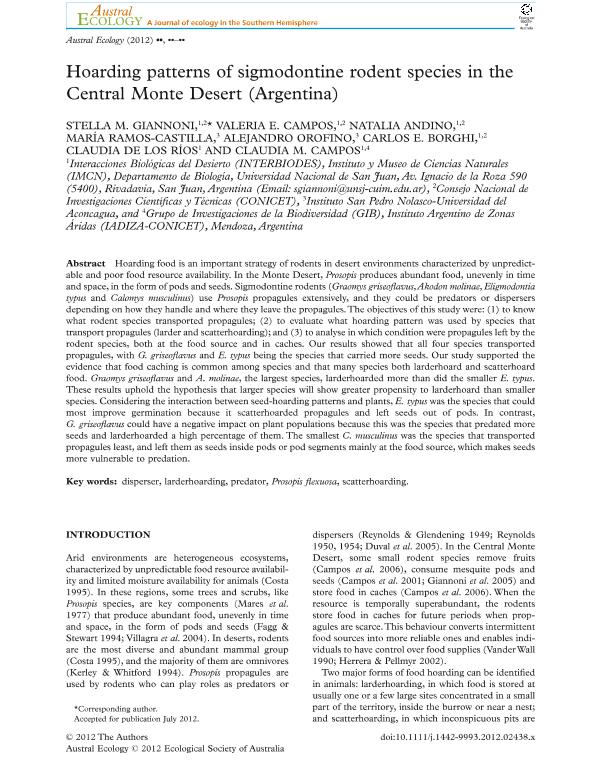Artículo
Hoarding patterns of sigmodontine rodents species in the Central Monte Desert (Argentina)
Giannoni, Stella Maris ; Campos, Claudia Monica
; Campos, Claudia Monica ; Andino, Natalia del Pilar
; Andino, Natalia del Pilar ; Ramos Castilla, Maria; Orofino, Alejandro; Borghi, Carlos Eduardo
; Ramos Castilla, Maria; Orofino, Alejandro; Borghi, Carlos Eduardo ; De los Rios, Claudia; Campos, Valeria Evelin
; De los Rios, Claudia; Campos, Valeria Evelin
 ; Campos, Claudia Monica
; Campos, Claudia Monica ; Andino, Natalia del Pilar
; Andino, Natalia del Pilar ; Ramos Castilla, Maria; Orofino, Alejandro; Borghi, Carlos Eduardo
; Ramos Castilla, Maria; Orofino, Alejandro; Borghi, Carlos Eduardo ; De los Rios, Claudia; Campos, Valeria Evelin
; De los Rios, Claudia; Campos, Valeria Evelin
Fecha de publicación:
08/2013
Editorial:
Wiley
Revista:
Austral Ecology
ISSN:
1442-9985
Idioma:
Inglés
Tipo de recurso:
Artículo publicado
Clasificación temática:
Resumen
Hoarding food is an important strategy of rodents in desert environments characterized by unpredict- able and poor food resource availability. In the Monte Desert, Prosopis produces abundant food, unevenly in time and space, in the form of pods and seeds. Sigmodontine rodents (Graomys griseoflavus,Akodon molinae,Eligmodontia typus and Calomys musculinus) use Prosopis propagules extensively, and they could be predators or dispersers depending on how they handle and where they leave the propagules.The objectives of this study were: (1) to know what rodent species transported propagules; (2) to evaluate what hoarding pattern was used by species that transport propagules (larder and scatterhoarding); and (3) to analyse in which condition were propagules left by the rodent species, both at the food source and in caches. Our results showed that all four species transported propagules, with G. griseoflavus and E. typus being the species that carried more seeds. Our study supported the evidence that food caching is common among species and that many species both larderhoard and scatterhoard food. Graomys griseoflavus and A. molinae, the largest species, larderhoarded more than did the smaller E. typus. These results uphold the hypothesis that larger species will show greater propensity to larderhoard than smaller species. Considering the interaction between seed-hoarding patterns and plants, E. typus was the species that could most improve germination because it scatterhoarded propagules and left seeds out of pods. In contrast, G. griseoflavus could have a negative impact on plant populations because this was the species that predated more seeds and larderhoarded a high percentage of them. The smallest C. musculinus was the species that transported propagules least, and left them as seeds inside pods or pod segments mainly at the food source, which makes seeds more vulnerable to predation.
Palabras clave:
Disperser
,
Larderhoarding
,
Predator
,
Prosopis Flexuosa
,
Scatterhoarding
Archivos asociados
Licencia
Identificadores
Colecciones
Articulos(IADIZA)
Articulos de INST. ARG DE INVEST. DE LAS ZONAS ARIDAS
Articulos de INST. ARG DE INVEST. DE LAS ZONAS ARIDAS
Articulos(SEDE CENTRAL)
Articulos de SEDE CENTRAL
Articulos de SEDE CENTRAL
Citación
Giannoni, Stella Maris; Campos, Claudia Monica; Andino, Natalia del Pilar; Ramos Castilla, Maria; Orofino, Alejandro; et al.; Hoarding patterns of sigmodontine rodents species in the Central Monte Desert (Argentina); Wiley; Austral Ecology; 38; 5; 8-2013; 485-492
Compartir



